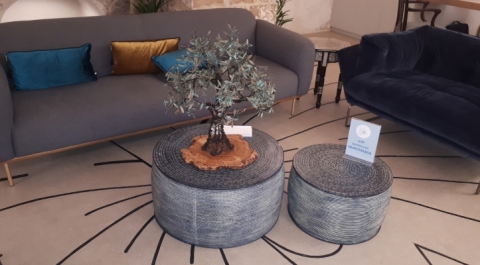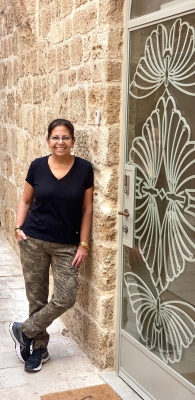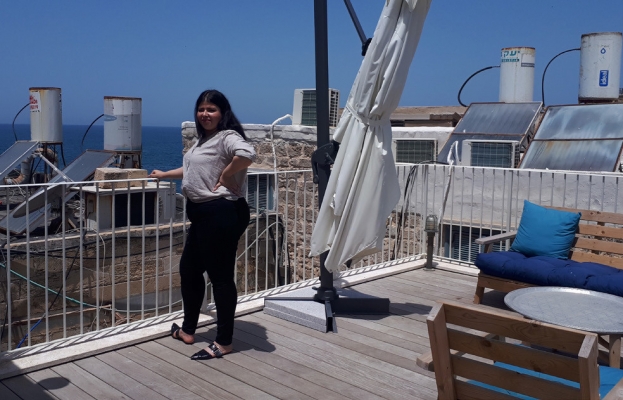Cathy Raff's Project in Akko
"What is a nice Jewish girl from Columbus, Georgia, doing in Akko, and why?"
When I started writing this article, I wanted to know what a nice Jewish girl from Columbus, Georgia was doing in Akko, and why she was doing what she was doing. Since then, the armed campaign unexpectedly launched on May 10 by Hamas but kept going by Israel, has forced me to view that question in a new light. And then, on May 12, even more unexpectedly, the reality, the politics, and the ineffecual government policies sparked internal riots and vandalism in Israel's major mixed cities such as Akko forced further re-thinking. Beit Elfarasha, Cathy's small boutique hotel and venue for traditional Akko Arab cooking seminars was saved by caring Arab neighbors on May12, but by May 13 the site was gutted. Cathy's dreams of using food to build bridges between communities, of female empowerment, and of straightforward pleasure in personal creativeness and project completion, seemed to be evaporating with the ashes and the broken glass.
Why, then, am I writing about a project that supposedly no longer exists? Well, because Cathy and her staff insist on keeping it going as a living, breathing vision in their hearts and minds. As I personally do not believe that Cathy is a contemporary Don Quixote, and because Beit Elfarasha did succeed, even if briefly, in nurturing coexistence, I'm presenting Cathy's and Beit Elfarasha story almost as it was originally written, in recognition of talent, commitment, dedication and the fruits of hope.
So, stepping back, what is a nice Jewish girl from Columbus, Georgia doing in Akko, and why? This is what I came to find out on a lovely Sunday afternoon in Tel Aviv, when I met with Cathy Raff at a café on the fringes of Rabin Squire. It was an appropriate setting. The late Prime Minister Yitzhak Rabin was assassinated for his efforts to achieve a living peace between Arabs and Jews; and here was Cathy, telling me about her start-up, the renovated ancient building in the Old City of Akko that she had transformed into an intimate guesthouse and venue for coming closer to Israel's Arab community through learning how and what to cook, Akko style. But more about the seminars later; Cathy comes first.
Cathy Raff, whose forefathers immigrated to the US from Russia, was born to an entrepreneurial family (her father opened the first McDonald's franchise in Columbus). Living in the deep South, where Jews lived few and far-between, attending services at the area's Conservative synagogue meant driving back and forth. I can only assume that this practice helped sensitize her to the need for flexibility and practicality when pitting one's values and goals against geographic and other constraints. She was therefore amenable to picking herself up and moving elsewhere to pursue her goals, first to the University of Austin in Texas, where she studied journalism, and then to the ArtCenter College of Design in Pasadena, California, where she studied photography. In between, she participated in the one-year study program given by The Hebrew University, during which she was smitten with Israel. All this was just a prelude to her 25-year career specializing in food photography and executive portraiture, her love of Israel and her Israeli husband, and her mothering of four children, all of which she seems to have managed rather well.
Then, in 1991, Cathy and her family vacationed in Akko. Everyone became enamored of Akko's Old City, its ancient harbor, architecture, food, and especially its residents. They kept coming back, to enjoy the Akko Festival of Alternative Israeli Theater, a performing arts festival usually held, pre-Covid-19, during Sukkot, and to witness the revival of Akko's ancient quarters, designed to attract tourists and improve the economy through preservation of the city's architectural, aesthetic, and historical values. They also got to know more and more of the local residents. With her artist's eye for the area's beauty, her photographer's understanding of the pull of tasty food arranged to attract diners, and the entrepreneur's focus on the practical side of starting a business, Cathy began formulating her new project: a guesthouse where the kitchen could be used to hold seminars teaching how to buy, prepare, and serve great food in the company of people sharing her appreciation of the beauty and pleasure of cooking, but also the sense of connection created by preparing -- and eating – dishes cooked together.
Beit Elfarasha
Beit Elfarasha (The Butterfly House), is located in an alley of the authentic Old City, is a smallish restored 200-year-old building containing some structural elements from the Ottoman period, just a few meters from the city wall and the sea beyond. The building's original structure has been carefully accented by internal walls quietly decorated with blue and white straw plates and some of Cathy's photos. Finding the right structure, and the artisans who could do the work, took about 10 years, with the assistance of the Akko Municipality's development authority. The obstacles faced included the year-long COVID-19 pandemic, which further delayed activities after the guesthouse's opening in December 2020. But a few months later, the violence and vandals, the rocks and flames arrived.
Cathy selected the butterfly to represent her project at the suggestion of her mother, who saw the butterfly's symbolic meaning as suitable to the project's aims. The butterfly's structure resembles a labyrinth, the ancient symbol for wholeness and tranquility. In combining the outlines of a circle and a spiral into a sinuous but purposeful path, the labyrinth represents a journey taken to our individual center and ultimate return to the world. The butterfly's curves, quite aptly, also resemble cooking utensils, such as whisks. El farasha, the Arabic word for butterfly, was ultimately chosen because the Arabic title represents the sense of community that Cathy so fervently wishes to create in her classes and her relationships with her staff.
The professionalism with which Cathy runs her project is obvious everywhere. First of all, she knows when and who to ask for help. During her successful career as a food photographer, she met some of Israel's superb chefs, such as Erez Komarovsky, who volunteered to train her in how to run cooking seminars. Aware of how much inter-ethnic relationships – or any relationship for that matter -- are nurtured by the stories people tell each other when learning how to flip an omelet or choose the right spice, Cathy turned to experts to instruct her cooks in the art of speaking, of storytelling, and of when to insert the right anecdote. During my visit I met the site's manager, Nura Kurdi, a 24-year old Muslim woman who had been educated at Akko's multi-lingual school, run by Italian nuns. Our conversation revealed her to be charming, sophisticated, and highly competent.
As to the cooks themselves, they were purposely selected from local residents. They qualified by preparing a six-course meal; these were evaluated by Cathy and a group of professional cooks, who tasted the results. Based on their evaluations, each woman's personality and communication skills, six were invited to join the staff. Akko's mixed ethnic and religious composition is reflected in the cook's backgrounds, which means, for example, that when a Christian cook is holding forth, wine will be included in the menu. Menus therefore change according to cooks home traditions. The women work in a cooperative manner, rotating in the roles of chief and assistant cook. Competition is left outside Beit Elfarasha's elegant door. Whatever income is earned from the 10-participant seminars is shared among the women, after covering expenses. Cathy tries to instill a sense of equality in order to promote a sense of community and coexistence, attitudes that would hopefully ensure the continuation of this self-sustaining project.
On the day we visited, twelve people were having a good time learning how to mash humous with a mortar and pestle, chosen for the amount to be ground. They included a mother and daughter, three couples, and friends celebrating a birthday (the staff can cater to special occasions). The atmosphere was easy-going but alert, as they watched the fresh vegetables bought in Akko's open-air market becoming edible. The participants occasionally nibbled at the fresh produce decorating the table. It felt as if no one would complain if the 1-day seminar went on forever.. Two days later everything did stop, at least for a while.
Cathy's determination and unpretentious appearance reminds us of how much character, a sense of what is truly important, and patience can bring people together. Two of Cathy's daughters had wanted to continue the project, and I hope they will. The empowerment enjoyed by the local cooks through participation in the project, and the support they enjoy from their husbands, may be the start of a new, enduring pattern of relations between men and women in their community. The hands-on economic model Cathy is following may also inspire other such projects because she has shown the possibility of creating immediacy and intimacy between strangers, free of the hype feeding so many community development projects.
I therefore believe that the answer to my opening question is: With a great deal of effort and support, and a little bit of luck, Cathy Raff, in envisioning the resurrection of Beit Elfarasha, is a nice Jewish girl from Columbus, Georgia who may be in the process of becoming a Phoenix arising from the flames set in Akko. Kol haKavod, Insha Allah












Comments